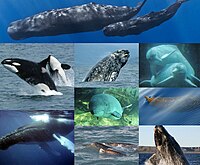
Photo from wikipedia
It is an ideal way to use triboelectric nanogenerators (TENGs) to capture energy from the environment for the degradation of organic contaminants in water as a zero-carbon pathway. However, there… Click to show full abstract
It is an ideal way to use triboelectric nanogenerators (TENGs) to capture energy from the environment for the degradation of organic contaminants in water as a zero-carbon pathway. However, there is an urgent need to further develop TENGs with a simple structure and high output power. Herein, a novel TENG with a vortex-like flexible self-recovery blades of inner stator (denoted as VFR-TENG) is designed and manufactured with the assistance of a fused deposition modeling 3D printing technology. With the rotation of the outer rotor, a facile rotating contact-separation mode is achieved by the alternating arrangement of the flexible self-recovery blades. The contact tightness of the friction layer, a key factor for the transfer of charge density, can be easily adjusted by the thickness and arrangement style of the flexible self-recovery blades. The regulation of material elasticity and rotational frequency on the output characteristics is further investigated based on the special flexible structure. The VFR-TENG exhibits an instantaneous short-circuit current of 350 μA, an open-circuit voltage of 650 V, a transferred charge of 1.1 μC, and an optimum output power density of 4.4 W·m-2. This high-performance VFR-TENG is used for electrochemical degradation systems, which achieves excellent degradation efficiencies of 88.9, 91.7, and 94.1% for methylene blue, methyl orange, and malachite green within 150 min, respectively. This work provides a new idea for the design of flexible self-recovery contact-separation TENGs, which is of great inspiration for the exploitation of TENGs with both the high peak current and high-frequency characteristics for efficient water treatment.
Journal Title: ACS applied materials & interfaces
Year Published: 2022
Link to full text (if available)
Share on Social Media: Sign Up to like & get
recommendations!